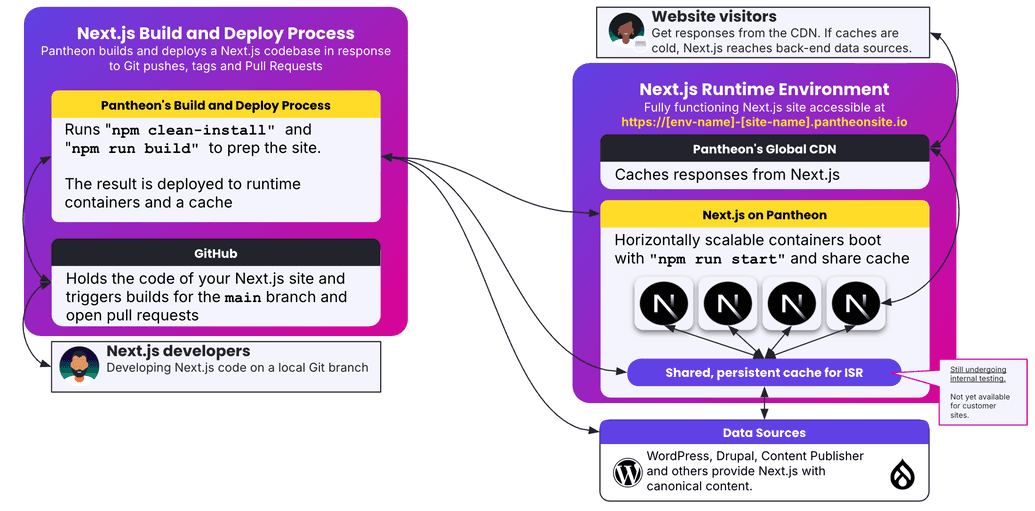Next.js Build and Runtime Architecture on Pantheon
Next.js runs in Node.js containers on Pantheon behind a CDN with static assets served from an object storage service.
This documentation describes support for Next.js that is under active development and is available only to customers who have been individually approved as part of our Private Beta program.
To request an invite, submit this form.
If you are migrating an existing Next.js site from our Front-End Sites offering please see our guide on migrating from Front-End Sites.
Pantheon hosts Next.js in containers running Node.js behind a global CDN. Those containers can read and write static assets to a persistance cache that are shared across all containers in an environment for a given site.
Both the containers and the cache are populated by the result of a build process which prepares Next.js by running npm clean-install and npm run build on a codebase.
Moving code from your local machine to Pantheon

Build and Deploy Process
In response to pushes to the main branch of your repository, or to open pull requests, Pantheon will run a build and deployment process.
This process is initiated by Pantheon's GitHub application, which you will need to install and authorize for your repository.

This process includes the following steps:
- Clone the repository at the commit that triggered the build.
- Run
npm clean-installto install dependencies. (The exact command isnpm ci --quiet --no-fund --no-audit (NODE_ENV=development). Share your thoughts on under which conditions Pantheon should useNODE_ENV=production.)- Pantheon uses
yarnorpnpmif ayarn.lockorpnpm-lock.yamlfile is present in the repository root instead of apackage-lock.jsonfile.
- Pantheon uses
- Run
npm run buildto build the Next.js application. - Deploy the resulting build artifacts to Pantheon, including:
- Uploading static assets to the shared cache.
- Package and upload the application code and dependencies to be run in Node.js containers.
The progression of these steps can be monitored using the Terminus command line interface using the terminus node:logs:build:list site-name.env command to list recent builds for a given site and environment.
You will observe statuses that indicate the progress of the build and deployment process such as BUILD_QUEUED, BUILD_WORKING, BUILD_SUCCESS, DEPLOYMENT_QUEUED, DEPLOYMENT_WORKING, and DEPLOYMENT_SUCCESS.
Failures during the build or deployment process will be indicated with BUILD_FAILURE or DEPLOYMENT_FAILURE statuses.
Accessing the deployed application
The resulting Next.js application becomes available on Pantheon once the deployment is complete at the URL specific to the site and environment.
The URL pattern is https://<env>-<site>.pantheonsite.io, where <env> is one of ,pr-* dev, test, or live, and <site> is the unique site name determined at site creation time.
For environments specific to pull requests, the pattern includes the pull request number, e.g. https://pr-42-mysite.pantheonsite.io for pull request number 42.
Deployments to Test and Live environments are triggered by Git tags. Learn more about deploying to Test and Live environments.
Runtime architecture
When a request is made to a Next.js site hosted on Pantheon, the request first hits the Global CDN.
From there, requests are routed to one of the Node.js containers running the Next.js application. These containers can use a cache handler to read from the Full Route Cache which containers prerendered HTML and React Server Component Payloads. When Next.js finds a usable cached response, it quickly serves that directly to the client.
The shared cache which enables Incremental Static Regeneration behavior is currently undergoing internal testing.
Cache misses trigger Next.js to render the requested page, often requiring content to be fetched from external data sources like WordPress, Drupal, or Content Publisher. The returned HTML and React Server Component Payloads are then stored in the Full Route Cache for future requests. This behavior is called of repopulated the cache with fresh versions of webpages is called Incremental Static Regeneration.